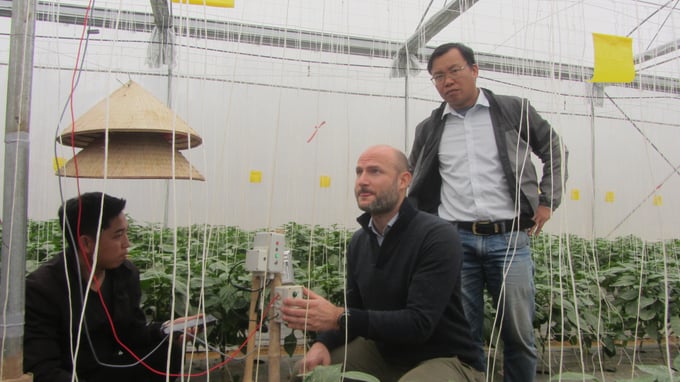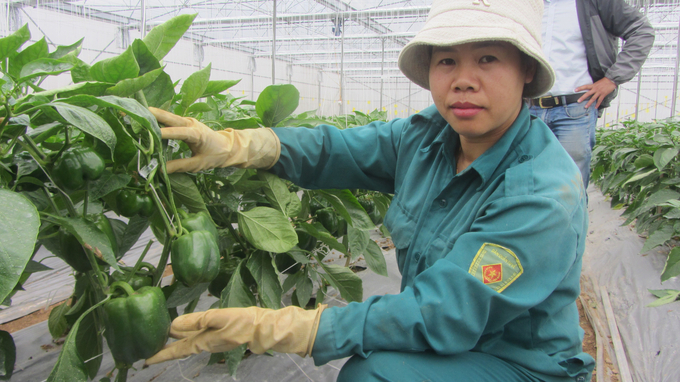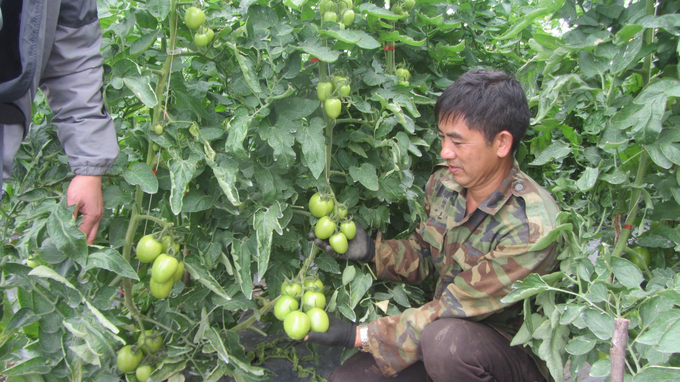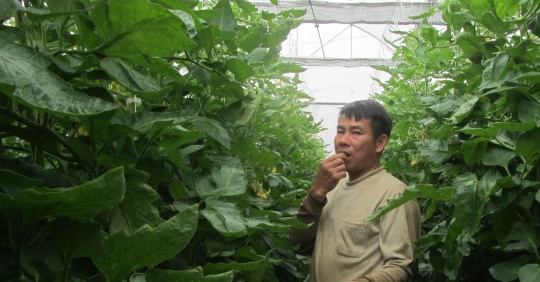Fulfilling the tasks assigned by the Ministry of Agriculture and Rural Development, the Fruit and Vegetable Research Institute collaborated with FAO to implement the “Smart Agriculture for Future Generations” project in Son La Province.
FAO technical expert Mr. Leone said that Moc Chau is a cool weather place similar to Da Lat (Lam Dong), which is very suitable for growing vegetables all year round, especially high-quality vegetables moderate origin.
However, the level of vegetable production technology of the farmers in Moc Chau has not caught up with Da Lat. And like Da Lat, outdoor vegetable production often faces adverse weather conditions such as rain, wind, fog and pests, so it is necessary to have a strategy to develop vegetables in greenhouses and net houses to ensure productivity. , product quality.

Mr. Leone (FAO Technical Expert) teaches gardeners how to use soil temperature and moisture meters, air temperature and humidity. Picture: HaiTien.
To promote smart production, help increase income, create sustainable livelihoods for the people of Moc Chau in particular, and improve the national capacity to produce greenhouse vegetables in general, the food and agriculture organization The United Nations Food and Agriculture Organization (FAO) has worked with the Ministry of Agriculture and Rural Development of Vietnam to set up the Smart Farming for Future Generations project in Son La Province.
The Fruit and Vegetable Research Institute was commissioned to be directly involved in the implementation of the project. Funding is provided by the Government of Korea through the FAO.
The project consists of 4 main components: modernization and optimization of 17 existing greenhouses and nurseries in Moc Chau (the size of each greenhouse is between 500 m2 and 2,000 m2); Building a model for the production of vegetables with high economic and nutritional value in net houses, greenhouses (peppers, tomatoes, cucumbers…); perfecting and increasing seedling production for nurseries; Post-harvest preservation and processing of agricultural products (pre-processing, packaging, preservation); product safety management; Value Chain Market Analysis and Connection of Fruit and Vegetable Consumption Markets.
So far, the project has completed and modernized the greenhouses (net houses, greenhouses) as planned. The Vegetable and Fruit Research Institute provided technical training to three growers in Moc Chau who planted and masterfully grafted vegetable seedlings, and also provided 40 million grafted tomato plants for the project’s greenhouses, which grow nearly 2 hectares of coffee, sour and peppers begin to harvest.
The harvest season lasts until the end of the year. Productivity is expected to reach 110-130 tons of fruit/ha for pepper gardens and 180-200 tons/ha for tomato gardens.

Grower Le Thi Hien looks forward to growing big, beautiful peppers and selling them at a great price. Picture: HaiTien.
Visiting the project’s greenhouses in Muong Sang, Dong Sang, Dong Luong, Phien Luong, Chieng Hac communes and Tien Tien sub-area, each greenhouse is equipped with measuring devices for soil temperature and moisture, temperature and humidity. connected to the garden owner’s smartphone.
In addition, there is an automatic irrigation and fertilizing system, beds with agricultural tarpaulins to keep the soil moist, sun protection nets and anti-insect nets that ensure optimal conditions for the growth and smooth development of the plants.
Gardener Tran Thi Hien (in the project) in Village 83, Phien Luong Township planted 900m2 of peppers, the first batch collected 200kg of fruit, which was sold through traders for VND7,000,000.
Ms. Hien found that greenhouse-grown peppers are pest-free, less prone to disease, larger and more beautiful, so they are sold by traders at a price 1.5 times higher than the same variety of chili grown outside of the greenhouse . Total fruit production is estimated at 12 tons (118 tons/ha), 3-4 times higher than pepper gardens without greenhouses.
In order to achieve the above fruit yield, Ms. Hien must regularly monitor the technical parameters reported on her smartphone, then set the care mode so that the soil moisture is always on the threshold of 70-75%, the temperature of the air in the garden is between 22 and 28 degrees Celsius, humidity between 65 and 70%, soil temperature between 20 and 22 degrees Celsius.
When the air temperature in the garden is higher than 30 degrees Celsius, Ms. Hien will use a trellis to cut the sun, the humidity exceeds the optimal threshold, the ventilation and air intake fans need to increase, the soil moisture is too low, or the pepper plants grow poorly . , need to increase the time of watering, fertilizing …

Mr. Nguyen Van Duyen boasted of having planted an infinitely productive, very fruity tomato variety that is to be harvested continuously until the end of the year. Picture: HaiTien.
Mr. Nguyen Van Duyen (household participating in the project) in Ta Liet Village, Chieng Hac Municipality, very much agreed with Ms. Hien’s assessment and said enthusiastically that he was supported by the project to upgrade 1,200 m2 greenhouses for tomato cultivation and 600 kg fruit sold.
Because there is less need to spray pesticides, the fruits are more beautiful, the quality is better, so the price is 12,000 VND/kg, if you calculate quickly, you can also get half the old profit (more than 50%) The profit is 1 .7 times higher than for tomatoes grown outside the greenhouse.
Since it is an infinitely growing variety, the tomato harvest time lasts 8 – 9 months. The fruit production is expected to reach 21 tons at the end of the season, which corresponds to a yield of 180 tons of fruit/ha.
Satisfied with the results achieved, Mr. Duyen built another 1,000 m2 of greenhouses for tomato cultivation. Mr. Duyen firmly said that the price of tomatoes will continue to rise because it is summer in the lowlands, it is impossible to grow tomatoes, then Moc Chau’s vegetables become scarce.
Mr. Nguyen Thai Thinh (technical coordinator of the project) said that the project had to be postponed for more than a year due to the impact of the Covid-19 epidemic, but the first results obtained are very encouraging from international partners, products are also used by many agricultural ones Bought outsourcing chains in Hanoi.
After tomatoes and peppers, the project will continue to use hydroponics of cantaloupe, peppers, tomatoes… on coconut fiber substrate no longer attacked by chemical agents.
“Sa Pa (Lao Cai) can also grow temperate vegetables, but the terrain here has many steep hills, heavy rains and storms, and there are many cold days in winter (below 13 degrees Celsius), even down to 0 degrees Celsius, in Investing in Moc Chau (Son La) to become a high-tech vegetable production center like Da Lat is a step in the right direction. However, the land fund for vegetable cultivation specialization here is gradually shrinking, so it is necessary for the locality to develop a plan to convert crops with low profitability to give priority to the conversion to high-tech vegetable cultivation,” Nguyen Thai said .. Thinh sees more.

